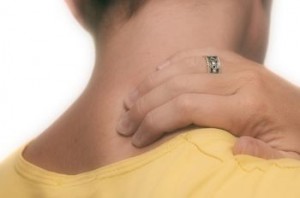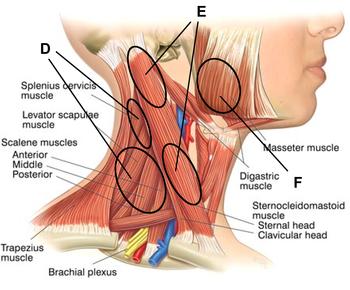How’s that headache or stiff neck?
 It’s a common moment in clinic when someone is complaining of a main condition such as low back pain. I note on the New Patient form that they are also suffering from headache or stiffness in their neck, as if this is expected! I always find it’s strange that our bodies can change and require repair but we’ve got so used to the discomfort that we start to see the symptoms as ‘normal’. The conversation usually goes like this:
It’s a common moment in clinic when someone is complaining of a main condition such as low back pain. I note on the New Patient form that they are also suffering from headache or stiffness in their neck, as if this is expected! I always find it’s strange that our bodies can change and require repair but we’ve got so used to the discomfort that we start to see the symptoms as ‘normal’. The conversation usually goes like this:
Chiro: ‘So how long have you had these headaches/stiff necks?’
Patient: ‘Well, as long as I can remember.’
Chiro: ‘And how often do you feel the symptoms?’
Patient: ‘Oh. every day/few days/week.’
If you stood on a pin every week, would you get used to it? Probably not, but dull pain can be very persuasive! It comes quietly, arrives more with age and is often associated with a grunt. That may seem normal, but if you don’t have someone to look after the movement of your spine, or you don’t use regular, specific exercise – given to you prescriptively such as by a physiotherapist, chiropractor or osteopath – you may need to get some.
 The neck is made up of seven vertebrae, the most important of which are the top (atlas) and bottom (cervico-thoracic junction). In the middle is a forward curve known as the cervical (neck) lordosis (said forward curve). Dysfunction of the movement of these vertebrae, along with dysfunction or knotting of the fine neck muscles, is the start of neck discomfort. Long term lack of motion causes stiffness in turning and consequently having to angle the car at a junction to make up for the lack of free turning.
The neck is made up of seven vertebrae, the most important of which are the top (atlas) and bottom (cervico-thoracic junction). In the middle is a forward curve known as the cervical (neck) lordosis (said forward curve). Dysfunction of the movement of these vertebrae, along with dysfunction or knotting of the fine neck muscles, is the start of neck discomfort. Long term lack of motion causes stiffness in turning and consequently having to angle the car at a junction to make up for the lack of free turning.
Locking of these vertebrae occurs like panes of glass pressing up against each other. If the surfaces press the air out when squeezed together, they form a vacuum and the two temporarily work as one. This may also mean three work as one, four, etc… anything up to seven. No, I have not yet come across someone with seven fixed vertebrae in my 18 years of chiropractic service, though there have been some close cases. More often than not, these are irreversible cases, due to neglect, and require xraying to determine if there is an underlying cause other than being far beyond one’s MOT!
Headache is often the combination of restriction of the upper neck, along with muscle spasm beneath the skull. From these sensitive and highly innervated soft tissues (the upper neck vertebrae are the most highest innervated joints of the whole spine) there are a number of triggers for what we commonly refer to as headache. Firstly there is referral of pain from muscle trigger points. The knots, or ‘trigger points’ (if you press specific points or triggers on a muscle, they refer pain just like another person’s) are simply poor areas of muscle circulation or tension. These often correlate with acupuncture points to about a 75{c8c3b3d140ed11cb7662417ff7b2dc686ffa9c2daf0848ac14f76e68f36d0c20} accuracy, indicating there is a lot more for us to learn about them than simply seeing them as tough areas of muscle fatigue.
Secondly, there are ligaments that directly connect to the membranes around the spinal cord, causing pressure on these deep-pain sensitive structures, triggering pain sensation around the face and head. Finally, there are nerves that must penetrate through these suboccipital muscles in order to get from the spinal cord to through the musculoskeletal system to the outside skin. These are known as the greater and lesser occipital nerves, which innervate the scalp. This is often a cause for children to not want their hair combed as the nerves are heightened in their sensory function (i.e. irritated) due to suboccipital trauma. If you’ve read some of my former articles you will note the interest in paediatrics and birth trauma is a significant cause of suboccipital compression or muscles spasm.
 Treatment is varied and many options are available. Massage helps relieve the chronic muscle tension; stretching helps to reset the muscles to their former length; acupuncture helps to break up the muscle trigger point and reset the energetic balance; Bowen therapy resets the pre-trauma receptor tone to try help the muscle let go but no therapy other than chiropractic; and osteopathy restores the locked bony joint beneath it all. This can often be the recurrent trigger and is where arthritic change occurs, the longer it is left to wear through poor movement.
Treatment is varied and many options are available. Massage helps relieve the chronic muscle tension; stretching helps to reset the muscles to their former length; acupuncture helps to break up the muscle trigger point and reset the energetic balance; Bowen therapy resets the pre-trauma receptor tone to try help the muscle let go but no therapy other than chiropractic; and osteopathy restores the locked bony joint beneath it all. This can often be the recurrent trigger and is where arthritic change occurs, the longer it is left to wear through poor movement.
Its so easy to change. Take that lovely body of yours and look after it with a trip to a chiropractor, or some of the other treatments I have mentioned. Often a chronic case may need more therapies to influence the area and the potential for a resolution and a return to normal. Can you remember normal? Often you need to have the treatment to feel what that is again…
And to top it all, we even offer you a free check so that we can advise you on whether you’re suffering from any form of ailment as mentioned above.
Here’s to optimizing your health naturally!
Michael Noone (chiropractor)

